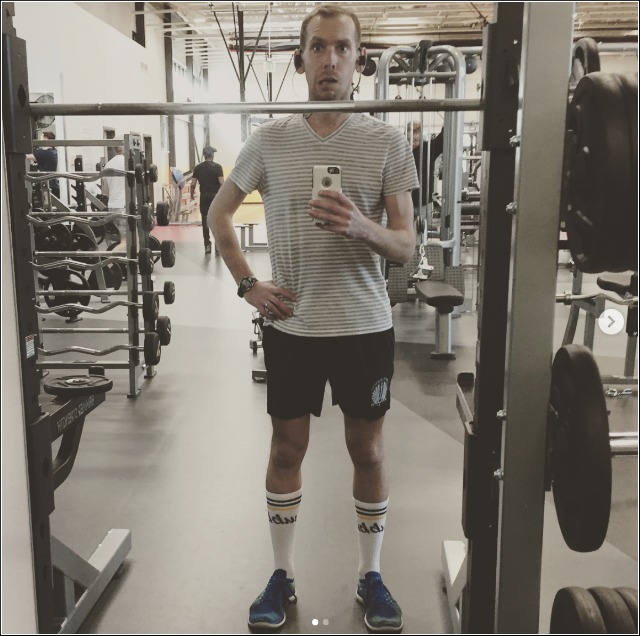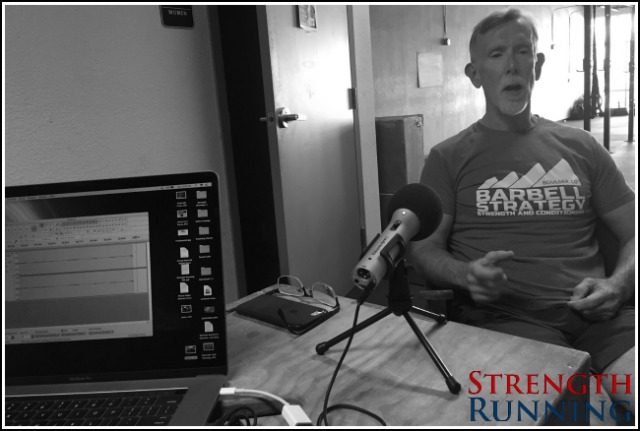I love runners who want to improve. They’re learning animals, always vacuuming up knowledge about this great sport.

It’s not how much you lift, it’s how good you look doing it. More on Instagram
And I have to agree: learning more about running is one of the best ways to get faster, avoid injury, and boost your endurance.
Why?
Because applying knowledge triggers the learning process and creates wisdom. With wisdom comes a lot of benefits:
- You make fewer training errors, resulting in fewer running injuries
- With less time injured, you develop consistency and run more
- Workouts and long runs become more strategic and productive
- Season planning, race strategy, and training progressions become more sophisticated
All of a sudden, you’re a smart runner making smart decisions. And you get a lot faster!
The goal of Strength Running is to elevate the sport by educating runners about proper training and inspiring you to do the necessary work to improve.
That’s why I encourage you to invest in your running, get guidance when you need it, and read more books about running.
But often, I don’t have all the answers (nobody does!). That’s why I love bringing in experts:
- I’m not a diet expert, but I partnered with a Registered Dietitian
- I’m not a sprint coach, but I love bringing them to you
- I’m not a sports psychologist, but their expertise on “mental training” is invaluable
And today, I’m bringing you some wisdom from our favorite weight lifting coach Randy Hauer.
Think About Training From Many Perspectives

It’s highly productive to think about running from different perspectives:
- How would a strength coach evaluate your training?
- Would a sprint coach modify your speed workouts?
- How does a sports psychologist prepare for the mental side of racing?
As you can see, other professionals give us a more nuanced, deeper understanding of running and performance improvement – and that knowledge is a competitive advantage.
Below you’ll see that the topics Randy and I discuss aren’t strictly limited to strength training. But that’s a good thing: it allows us to think about running from new perspectives.
And I think there’s a lot of value in that exercise.
Let’s get started. Below you’ll find excerpts from an email exchange and a conversation between Randy and I about all sorts of training issues. I hope you enjoy this.
Lesson #1: Ego is the Enemy
Randy shared a short story with me:
“One of my male high school sprinters who DID like lifting is now an athlete at Brown. He started with empty bar like everyone else 3 years ago.
He now hang power cleans 250lbs for reps at a bodyweight of 175lbs (same bodyweight as in high school) and his times, of course, have improved with his strength.”
What’s the lesson here?
In my mind, it’s that if a young, Division I collegiate sprinter at his peak starts lifting with the bar, you should, too.
Many runners get hurt because they let their ego get in the way of reasonable training decisions. They fall prey to the “3 Too’s” that lead to injuries: running too much, too fast, too soon.
The same can be said for weight training. Lifting too many sets or reps, with too much weight, before you’re ready is a recipe for injury.
Start with reasonable weight (or mileage). Progress intelligently. Listen to your body. Don’t satisfy your ego.
Lesson #2: Good Posture Requires Strength
Many runners are surprised to hear that I typically don’t recommend a “forward lean” when it comes to proper running form.
Why? Because leaning from the ankle (rather than the waist) requires strength that most runners don’t have.
The solution is strength training and Randy has some great real-world examples:
“When I get new runners, the first thing they notice is an improvement in posture. It’s just less taxing to stay upright while they run. This is key.
As the postural muscles fatigue, the respiration muscles start pitching in which interferes with their prime function: breathing. The more fatigued the postural muscles get the harder it gets to breathe.
Squat, presses, deadlifts, and explosive lifts all work the postural muscles. Big payoff, which is again not so obvious.”
In sum, if you want to retain great posture while you’re fatigued and running fast, you have to get strong!
A sound weight lifting for runners program will take this into consideration (if it only includes core work, you know you’re not doing it right).
Lesson #3: VO2 Max isn’t Everything
Back in 2010 I participated in a study that require a VO2 Max test. It was exciting to learn more about this metric but afterward, it had absolutely no impact on my training.
That’s because it’s not something that runners actively try to improve because it does not mean you’ll race faster.
In other words, a higher VO2 Max does not mean you’re going to become a faster runner.
This sets off a fascinating discussion about endurance and speed, which Randy dives into below:
“There is a huge genetic component to speed that can’t be ignored.
For example, Paula Radcliffe had a slightly higher Vo2 max in high school than when she set the marathon world record. Her best half marathon time was about ~2 seconds per mile faster than her best 3k time when she was 17.
With proper training, anyone’s speed can be improved and taught to endure, but there are limits.”
The lesson? Speed development has its limits, but endurance can theoretically always be improved.
Lesson #4: Speed First
I’ve often tried to impress upon runners several ways to think about speed:
- Speed requires more coordination, strength, and power (and helps you build these physical skills)
- Very fast running also reinforces proper running form
- A runner’s “range of available speed” increases the faster your Personal Bests become
Therefore, I think it’s beneficial for runners to focus on shorter races earlier in their careers and longer races later in their careers.
We can see the benefit of this approach in Galen Rupp’s explosion onto the marathon scene over the last few years. Randy notes:
“One of the announcers at Chicago Marathon had it right when he noted the Africans went out too slow to truly test Rupp (10k and Marathon Olympic medalist) over the distance. They basically gave him a 20 mile warm up and then he raced the remaining 10k alone to the finish.
He has that fundamental speed in reserve. He does do regular weight training with the Nike Oregon Project, too.”
Rupp has “fundamental speed in reserve.” With just a bit more focus on endurance, he’s successfully transitioned from a middle-distance specialist to a marathoner.
Many of you will notice this echoes my common suggestion to train for a fast 5k or 10k once you’ve fully recovered from the marathon.
Varying the focus of your goal race means you’ll vary the focus of your training. And those faster workouts (those that you’d never do for the marathon) improve your fitness, coordination, speed, and power in ways that marathon training never will.
Get fast first and then extend that speed with endurance!
Lesson #5: Want a smooth stride? Lift weights
I get this question about once a week:
How do I improve my running form? Fast runners make it look so easy… almost effortless!
Well, it’s never without effort. But you certainly develop a smoother stride the stronger you get. Randy is adamant about this:
“Strength training teaches your Central Nervous System (CNS) to coordinate which muscle fibers to use and when (called inter-muscular coordination).
It also teaches your CNS to more efficiently coordinate which muscle groups to fire and which to relax (intra-muscular coordination), often improving running technique without even addressing it directly.
Runners who know Maggie, for example, have commented to her and me after races how much her form has improved over the last couple of years.”
A smooth, powerful stride is the result of many skills being expressed at once:
- Strength
- Efficiency
- Power
- Coordination
And those skills are all built with strength training! Get started here.
Lesson #6: Strength Builds Speed
Mitochondria are found inside your cells and they essentially have the job of respiration and producing energy for your body.
One of the main benefits of endurance training is the densification of cellular mitochondria, allowing you to run faster for a longer period of time.
But that’s not the only way of creating more mitochondria – you can also start lifting weights! Randy sheds some light on this aspect of weight training:
“Strength training also has a positive effect on the cellular level by improving an athlete’s ability to clear lactate by building more mitochondria and the transport proteins that shuttle lactate. The better at lactate clearance, the faster you go.
Studies have shown that endurance athletes who strength train have more mitochondria than those who do not.”
Runners who have any type of time-based goal should think about weight lifting as a key component to their training.
Attacking the problem of building more mitochondria from two different sides (endurance work and lifting weights) is far more productive than relying on just one mechanism.
How to Implement this Advice
There’s a lot of helpful running advice in this one post. What’s the best way of using it to your advantage?
Three main lessons jump out at me:
- Endurance can theoretically always be improved. Run a lot, run long, and do so consistently.
- Don’t ignore speed: train for a short race at least once per year and do regular speed work to maintain this skill
- Lifting weights is invaluable. Start lifting weights if you’re not already.
Since Randy is a strength coach (and works with quite a few elite runners), much of this discussion focused on the valuable benefits of weight lifting for runners.
We’ve partnered together to create a program called High Performance Lifting that’s one-of-a-kind: the only program developed by a USA Weightlifting National Coach and a USA Track and Field certified coach that:
- Is advanced enough to be used by elite runners
- Is approachable enough to be used by almost anybody
- Includes 16 weeks of detailed programming with HD video demonstrations
If you’re not sure how weight lifting for runners is structured, this is your opportunity to learn exactly what to do (without wasting your time on what’s not important).
You can also sign up here for our free email course that goes into more detail about these concepts.
Either way, use these training lessons to your advantage so your next race will be your next Personal Best!